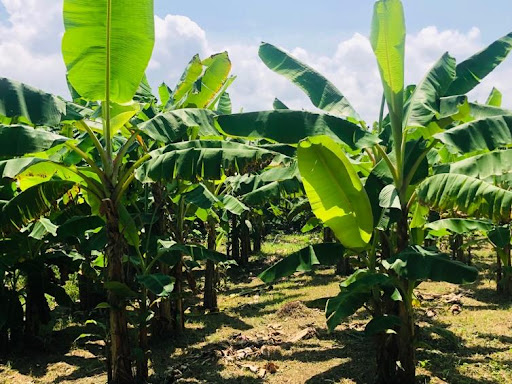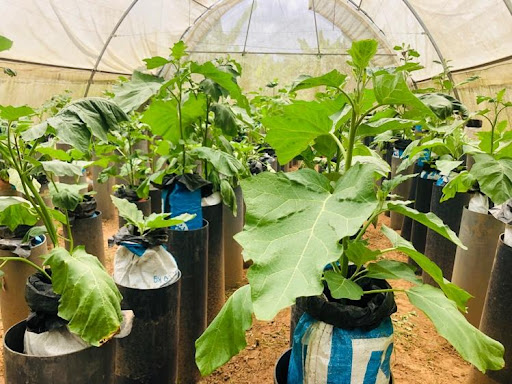Production of plantation under organic conditions
Organic gardening is the process of cultivating and producing agricultural products utilising organic farming practises. At the Alexander Carson Technology Village at the University of Cape Coast, organic farming activities strives to employ natural systems and processes to improve soil health, encourage biodiversity, and reduce the need of synthetic inputs such as chemical pesticides and fertilisers. Practices that contributes to sustainably farmed food on campus includes; soil management, Non-GMO seeds, natural fertilizers, pest and disease management, weed control and livestock integration. Others include water conservation, certification and continuous improvement. Compared to conventional agriculture, organic farming can result in healthier soil, higher-quality products, and less negative environmental effects. However, it does require a dedication to sustainable and ecologically friendly practises.
Production of Garden Eggs
Garden eggs, sometimes referred to as eggplants or aubergines, can be grown organically in a screen house and can be a rewarding and long-lasting gardening technique. The picture below shows practices of cultivating garden egg under organic conditions in the screen house otherwise known as green house at the Alexander Carson Technology village at the University of Cape Coast. Without the use of synthetic chemicals, organic gardening involves employing natural methods to encourage plant development and control pests.
You may grow healthy and delicious garden egg fruits in your screen house without using artificial chemicals by adhering to these organic gardening techniques. Keep in mind that organic gardening is a holistic method that emphasises the wellbeing of the soil, plants, and surroundings.
Area of land allowed to fallow
A piece of land can be left fallow for a variety of agricultural and environmental reasons. Fallowing is the practise of not planting or cultivating farmland for a predetermined amount of time. The University of Cape Coast Department of Soil Science recognises the advantages of these practises, therefore among other things, the University of Cape Coast Research Farm practises soil restoration, nitrogen replenishment, weed and pest control, and water conservation. It's crucial to keep in mind that the decision to leave land fallow depends on a number of variables, including the local climate, soil type, agricultural practises, and the landowner's objectives.
A field of mahogany intercropped with sweet potato under agroforestry system
Agroforestry systems, which combine the cultivation of food crops like sweet potatoes with the cultivation of timber trees like mahogany on the same plot of land, are environmentally friendly and sustainable agricultural practises. An example would be a field of mahogany intercropped with mahogany trees. In addition to fostering biodiversity, soil health, and long-term sustainability, this strategy attempts to make the best use of the space and resources that are already available. About this agroforestry system, see this information.
In an agroforestry system, intercropping mahogany and sweet potatoes is a sustainable land use technique that has a number of environmental, financial, and social advantages. It demonstrates the opportunity to combine the development of fruitful trees with the production of food crops to develop dependable and environmentally sound agricultural systems. This is what the Department of Crop Science at the University of Cape Coast does at the school farm.
Multiplication of cassava varieties that are resistant to the casava mosaic virus disease
There are many kinds of concerns and stages involved in multiplying cassava varieties that are resistant to the cassava mosaic virus illness. CMV, a dangerous disease that affects cassava plants and results in stunted development, decreased yield, and possibly crop loss. In areas where cassava is a staple crop, it is important to create and spread resistant varieties to protect food security and way of livelihood. The bulk of cassava produced in Africa is used for human consumption. This is due to cassava's remarkable carbohydrate yields, which are second only to yams and significantly higher than those of maize and rice. Variety selection and breeding, propagation, stem cutting preparation among others are all steps in the production and multiplication of resistant cultivars. Remember that while creating and propagating resistant cultivars is crucial, managing the cassava mosaic virus and ensuring long-term crop productivity also requires an integrated approach that incorporates sound agricultural practises such as crop rotation and pest management techniques. These practises are employed at the University of Cape Coast School and Research Farm to maintain food security on campus.
A field of moringa intercropped with both cowpea and maize under agroforestry system
It may be sustainable and fruitful to intercrop maize, cowpea, and moringa in an agroforestry system. Agroforestry mixes the planting of trees with agricultural crops to create a more diverse and robust farming system. The intercropping of moringa with cowpea and maize involves a number of steps for success, including site preparation, layout design, planting of the moringa, cowpea, and maize, mulching, and weed control. A successful agroforestry involves experimentation and local conditions to be taken into account. You may improve your strategy and create an economically viable and sustainable field of maize, cowpeas and moringa by regularly checking your progress and learning from your mistakes. It's a sustainable strategy that can deliver a number of advantages, including greater ecosystem services, diversified harvests, and improved soil health. At the Teaching and Research Farm of the University of Cape Coast, these practices are encouraged to ensure a sustainable farming.



